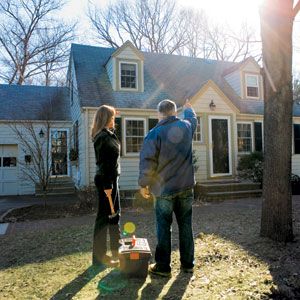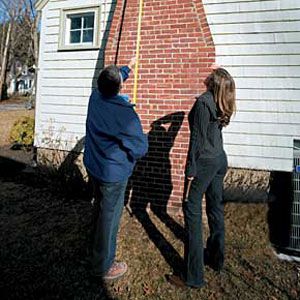This Old House general contractor Tom Silva has spent his career helping homeowners across America, but a recent assignment kept him closer to home—advising his daughter, Kate, 28, on the purchase and renovation of her first house. Tom and his wife, Susan, were thrilled when Kate said she was moving back to Boston from San Diego with her fiance, Jay. Naturally, Dad volunteered to help in the house hunt.
Tom found what he thought was the ideal place: a modest 1950s Cape with a nice piece of land, on a quiet, dead-end street. “It’s a perfect starter house,” Tom says. “It has three good-sized bedrooms, but it’s small enough that they won’t spend a fortune on heat. The land is flat and fenced in—great for their dogs..and a family, eventually.”
“Oh, and one other thing he forgot to mention,” says Kate. “It just happens to be 1.3 miles from his house.”
All the easier for Tom to drop by with his tools. Like many first-time home buyers, Kate and Jay soon learned that even a house in good move-in condition usually needs some updating. So what secrets about home ownership does Tom share with his own family? To find out, we listened in as he gave Kate a few words of professional—and fatherly—advice.
1. Get Your Priorities Straight
Like anyone who buys a new house, you and Jay will discover things you want to change once you settle in—like, say, that upstairs bathroom. Yeah, it’s totally out of date, the paint’s peeling, and the tiles are all cracked. But those are just surface things that you can live with.
I always say, “Spend on the things you can’t see before you splurge on expensive finishes.” If you blow your budget on a fancy bathroom, you won’t have anything left for basics—like heating and cooling. I have to tell you: This house’s forced-air system doesn’t have enough ducts on the second floor. I mean, what’s the point of a new bathroom if you’re shivering in your bedroom? But since this is your starter house, it’s not worth the expense of converting to hot-water heat. Just replace the ductwork. I’m not always a fan of forced air, but the ducts do make it easy to add central air—which we should probably get right on, because I hear this summer’s going to be pretty hot.
As for the bathroom, a new exhaust fan and a fresh coat of stain-fighting paint, like Kilz, will work wonders to make the peeling and mildew go away. Worry about the marble tile and the jet tub later.
2. Have a Plan and Stick to It
So many homeowners want their house to be finished the day they move in, from the bedroom color to the kitchen appliances. But when you bought the house, you budgeted for repairs you knew had to happen. Make sure that’s what you spend on. You may be anxious to blow out a wall and expand the kitchen—a $20,000 job, minimum. But remember how we noticed during the inspection that the pipes have been cobbled together with every material you can imagine? I’ve seen that in a lot of houses, and sooner or later the plumbing always fails. So it’s no use redoing the kitchen if the work will have to get ripped out to get to the pipes. You will have just wasted $20,000.
3. Sleep on It
I always tell people that it’s best to live in a house for a while—like a year—to get a feel for the space before making big design changes. For one thing, you have time to save up, and the costs are lower if you plan ahead and book a crew in advance instead of making it a rush job. But also, features of the house you thought you hated might turn out to be your favorites, and you could discover why other things are the way they are. Like an oddly shaped nook that you find out wraps around a plumbing stack. I’ve had lots of jobs where the homeowner said, “Now I get why they built it that way!” You have to live in a house, day and night, season to season, to truly know how you want it to be.

4. Consolidate Your Construction
Once you do figure out what you want to do, then make the most of the construction time and money. One of the best things about a house on a flat lot like yours is how easy it will be to add on—to bump out the kitchen into the backyard for that family room you want. What I’m suggesting is, while you’re at it, make it a two-story addition, and you’ll get a nice master bedroom suite above. The big expense is the kitchen; adding the upstairs space will just be an incremental cost. Plus you won’t have to go through the hassle of construction twice. That’s why I almost always recommend two-story additions.
5. Tighten Up
New ductwork and AC won’t do much good if the air all goes right back out of the house. So there are two things I tell every homeowner: Insulate, and deal with the windows. The San Diego weather has spoiled you, but you’ll know what I mean the minute it’s really hot or really cold.
I’ll help you beef up the insulation. We could blow in cellulose, but I’d rather use spray foam because it doesn’t need venting at the roof and makes an airtight barrier. Otherwise you’ll feel sticky in the humidity, even with the AC on max, and you’ll never get cozy on a windy day no matter how high you crank the heat. I say this to all my clients: It doesn’t matter where you live, you can’t have too much insulation.
But the windows on the first floor—they have to go. Usually I like to save originals like yours, maybe add storms over the single panes. But your sash haven’t been maintained well—they’re separating at the seams and missing a lot of the glazing putty that holds in the panes, so it’s not worth the time and expense of repairing them. Get some modern, dual-pane windows. They’re the best money saver you can have because of how much less you’ll spend on utilities.
6. Make Sure You Have the Tools
I won’t always be able to run over with my toolbox like a doctor with his black bag every time something needs fixing. Homeowners have to be prepared to make quick repairs, so get yourself some good tools. That way you can grab what you need when you need it.
Look, you don’t need a trailer full of tools like mine. You just need enough to handle the simple jobs. That means a good hammer, a set of screwdrivers, some pliers, a putty knife, two good paintbrushes, stable wrench, a 2-foot level, a crosscut saw, a hacksaw, a square, and, of course, a tape measure. For power tools, stick with a cordless drill and a circular saw—don’t forget the safety glasses and ear protection. Anything else can be added as your skills improve.
7. Go Looking for Trouble
By that I mean look for trouble on your house, Smarty. Twice a year, every spring and fall, pick a nice day when you and Jay can walk around and inspect the place for problems. Put on some gloves, grab a ladder, and check out all the parts of your house you don’t normally notice or get to see from the ground—the roof, the upper windows, the places where the siding meets the doors and windows. If something doesn’t look right, or needs a little repair—some loose gutters or a cracked windowsill—write it down. Or better yet, come back the next day and repair it. Which brings me to my next point…

8. Fix It Before It Breaks
I’m here to help with the big jobs, but as the owners of this place, the day-in, day-out maintenance is up to you. The trick is to take care of little things before they become big problems. I noticed some roof shingles are missing and that the caulking is cracked around some windows. That’s easy stuff for any homeowner to fix. If you wait until water can get in, it will start destroying the wood and you’ll need major work. Remember this mantra: Water is a house’s worst enemy.
9. Keep a To-Do List
That said, once you’ve finished your tour of the house and made a list of repairs, figure out which ones can wait. Not every fix has to happen right away, especially with a limited budget. There are many you can space out over time. Like the chimney repointing—you’ve got a few cracks at the top that need to be fixed. But they’re not letting water in, and the freeze-thaw cycle that caused the mortar to crack won’t be back for a few months. The garage door looks bad after 50 years, but it still goes up and down. It can wait, too. Now, the leaking bulkhead for the cellar stairs—that could wait, because it’s only a little water going to the slab floor, not the wood framing. But if you want to make use out of that space, you should fix it now.
10. Dry Yourself Out
Dollar for dollar, a basement is the cheapest space in your house. As long as you keep it dry, you can get a ton of use out of it—by making it into a workshop, or a family room, or even that media room Jay wants so he can watch the Red Sox. What’s great about a finished basement is that homeowners can save money by doing some of the work themselves. If I show Jay how to patch that leak in the concrete foundation with quick-drying hydraulic cement, then he can paint it with a masonry waterproofer. When he’s done, the place will be good and dry and ready for walls and floors.
11. Keep It in the Family
See? I’ve already got you and Jay working—you don’t really need me after all. But, really, doing hands-on projects together is a great way for a family to stay connected, and there are lots of things you need two people for. Like ripping out the old wall-to-wall carpeting, or cleaning out the gutters (one of you has to hold the ladder). But I’m really impressed by the work you’ve already done on the house, and how well you’ve taken to the responsibility of home ownership. One of these days, I’ll even come over for dinner and not bring my tools.

